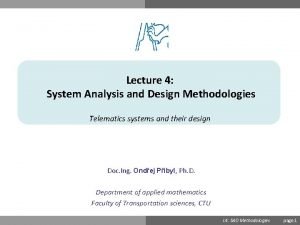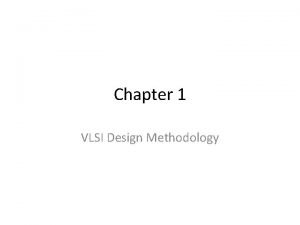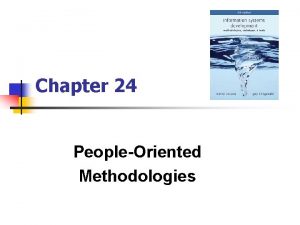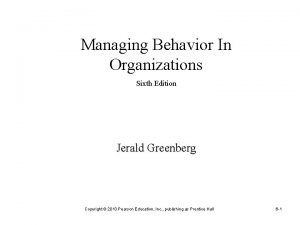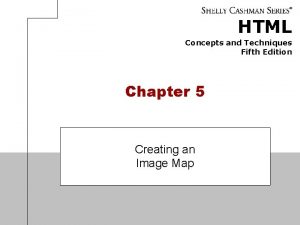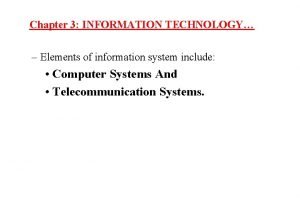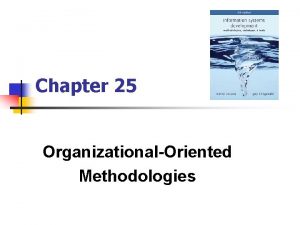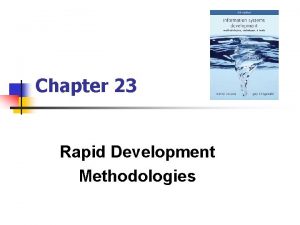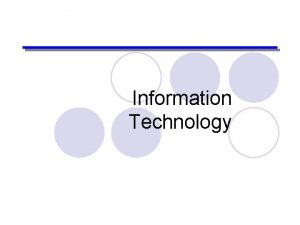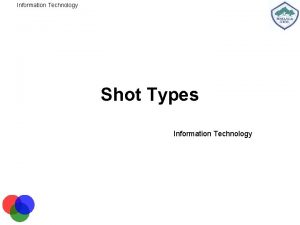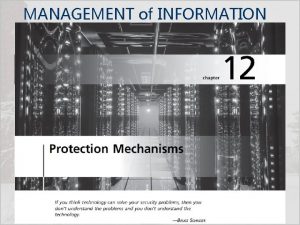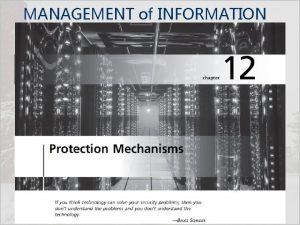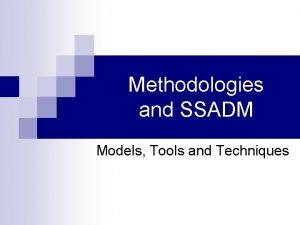MANAGING INFORMATION TECHNOLOGY FIFTH EDITION CHAPTER 10 METHODOLOGIES



































- Slides: 35

MANAGING INFORMATION TECHNOLOGY FIFTH EDITION CHAPTER 10 METHODOLOGIES FOR CUSTOM SOFTWARE DEVELOPMENT E. Wainright Martin Carol V. Brown Daniel W. De. Hayes Jeffrey A. Hoffer William C. Perkins

SYSTEMS DEVELOPMENT LIFE CYCLE METHODOLOGY Systems development life cycle (SDLC) – a highly structured approach for development of new customized software applications © 2005 Pearson Prentice-Hall Chapter 10 - 2 2 Page 385

SYSTEMS DEVELOPMENT LIFE CYCLE METHODOLOGY The SDLC Steps ic is ws t s i r vie cte e a r r l a ch h ma Key sive for d of eac n exte red at en i requ step r majo © 2005 Pearson Prentice-Hall Chapter 10 - 3 Figure 10. 1 The Systems Development Life Cycle 3 Page 386

SYSTEMS DEVELOPMENT LIFE CYCLE METHODOLOGY The SDLC Steps ch: a o r pp a C ent L p s D S e k of front tim nts to r a m Hall sive up- quireme es later e n g exte mining r e chan iv r dete expens d avoi © 2005 Pearson Prentice-Hall Chapter 10 - 4 Figure 10. 2 Cost Breakdown for $1 Million 4 SDLC Project Page 386

SYSTEMS DEVELOPMENT LIFE CYCLE METHODOLOGY The SDLC Steps SDLC: Most often requires a lot of documentation Outputs from one step inputs to next Often referred to as the “waterfall” model © 2005 Pearson Prentice-Hall Chapter 10 - 5 5 Page 386

© 2005 Pearson Prentice-Hall Chapter 10 - 6 6

SYSTEMS DEVELOPMENT LIFE CYCLE METHODOLOGY Definition Phase – Requirements Definition n Focuses on logical design: processes, data flows, and data interrelationships – not specific physical implementation n Deliverable – system requirements document: Detailed descriptions of inputs and outputs, processes used to convert input data to outputs Formal diagrams and output layouts Revised cost/benefit analysis Revised plan for remainder of project © 2005 Pearson Prentice-Hall Chapter 10 - 7 7 Page 388

SYSTEMS DEVELOPMENT LIFE CYCLE METHODOLOGY Construction Phase n System Design n System Building n System Testing © 2005 Pearson Prentice-Hall Chapter 10 - 8 of m s i han rocess c e tp rm n o j e a m s a m develop i n tio a t ing r n u e d n um Doc unicatio m com Figure 10. 3 Characteristics of High Quality Systems 8 Page 389

SYSTEMS DEVELOPMENT LIFE CYCLE METHODOLOGY Implementation Phase n Installation n Operations n Maintenance © 2005 Pearson Prentice-Hall Chapter 10 - 9 9 Page 390

Implementation Phase – Installation Parallel Strategy © 2005 Pearson Prentice-Hall Chapter 10 - 10 Figure 10. 4 Implementation Strategies 10 Page 391

Implementation Phase – Maintenance © 2005 Pearson Prentice-Hall Chapter 10 - 11 Figure 10. 5 Percent of Development 11 Resources Devoted to Maintenance Page 392

Implementation Phase – Maintenance © 2005 Pearson Prentice-Hall Chapter 10 - 12 Figure 10. 6 The Widening Gap Between 12 Page 392 Organization’s Needs and System’s Performance

SYSTEMS DEVELOPMENT LIFE CYCLE METHODOLOGY The SDLC Project Team n Usually temporary n Includes personnel from IS and business units n Has a project manager Traditionally from IS Can be from business unit May be one from each Responsible for success of project – delivering quality system on time and within budget © 2005 Pearson Prentice-Hall Chapter 10 - 13 13 Page 393

SYSTEMS DEVELOPMENT LIFE CYCLE METHODOLOGY The SDLC Project Team n Includes systems analysts Have critical roles Work closely with business managers and end users Have problem-solving skills, knowledge of IT capabilities, strong business understanding n Has a business sponsor and a champion © 2005 Pearson Prentice-Hall Chapter 10 - 14 14 Page 394

SYSTEMS DEVELOPMENT LIFE CYCLE METHODOLOGY Managing an SDLC Project n Characteristics critical for success: Manageable project size Accurate requirements definition Executive sponsorship © 2005 Pearson Prentice-Hall Chapter 10 - 15 15 Page 394

SYSTEMS DEVELOPMENT LIFE CYCLE METHODOLOGY Managing an SDLC Project (Adapted from Boehm, 1976) © 2005 Pearson Prentice-Hall Chapter 10 - 16 Figure 10. 7 Costs of Error Correction by SDLC Step 16 Page 395

SYSTEMS DEVELOPMENT LIFE CYCLE METHODOLOGY SDLC Advantages and Disadvantages © 2005 Pearson Prentice-Hall Chapter 10 - 17 Figure 10. 8 Advantages and Disadvantages 17 of Traditional SDLC Approach Page 395

PROTOTYPING METHODOLOGY n Prototyping approach: Takes advantage of availability of fourth generation procedural languages and relational database management systems Enables creation of system (or part of system) more quickly, then revise after users have tried it Is a type of evolutionary development process © 2005 Pearson Prentice-Hall Chapter 10 - 18 18 Page 396

PROTOTYPING METHODOLOGY n Prototyping examples: Input and output screens developed for users to test as part of requirements definition “First-of-a-series” – a completely operational prototype used as a pilot “Selected features” – only some essential features included in prototype, more added later Prototyping used as a complete alternative to traditional SDLC methodology © 2005 Pearson Prentice-Hall Chapter 10 - 19 19 Page 396

PROTOTYPING METHODOLOGY n Prototyping used as a complete alternative to traditional SDLC methodology: Good when requirements hard to define Good when system needed quickly Impractical for large, complex applications © 2005 Pearson Prentice-Hall Chapter 10 - 20 20 Page 396

The Prototyping Steps © 2005 Pearson Prentice-Hall Chapter 10 - 21 Figure 10. 9 The Prototyping Life Cycle 21 Page 397

PROTOTYPING METHODOLOGY The Prototyping Project Team n Representatives from IS and user management necessary n Need team members who can quickly build systems using advanced tools n Requires dedicated business user roles © 2005 Pearson Prentice-Hall Chapter 10 - 22 22 Page 398

PROTOTYPING METHODOLOGY Prototyping Advantages and Disadvantages n Advantages: Only basic requirements needed at front end Used to develop systems that radically change how work is done, so users can evaluate Allows firms to explore use of new technology Working system available for testing more quickly Less strong top-down commitment needed at front end Costs and benefits can be derived after experience with initial prototype Initial user acceptance likely higher © 2005 Pearson Prentice-Hall Chapter 10 - 23 23 Page 398 -399

PROTOTYPING METHODOLOGY Prototyping Advantages and Disadvantages n Disadvantages: End prototype often lacks security and control features May not undergo as rigorous testing Final documentation may be less complete More difficult to manage user expectations © 2005 Pearson Prentice-Hall Chapter 10 - 24 24 Page 399

PROTOTYPING METHODOLOGY Prototyping within an SDLC Process © 2005 Pearson Prentice-Hall Chapter 10 - 25 Figure 10. 10 SDLC with Prototyping to Define Requirements 25 Page 399

PROTOTYPING METHODOLOGY Prototyping within an SDLC Process © 2005 Pearson Prentice-Hall Chapter 10 - 26 Figure 10. 11 Prototyping/Piloting Replaces 26 SDLC Definition Phase Page 399

NEWER APPROACHES Rapid Application Development (RAD) n Hybrid methodology – aspects of SDLC and prototyping n Goal is to produce a system in less than a year © 2005 Pearson Prentice-Hall Chapter 10 - 27 Figure 10. 12 Four-Step RAD Cycle 27 Page 400

NEWER APPROACHES Rapid Application Development (RAD) Joint application design (JAD) – a technique in which a team of users and IS specialists engage in an intense and structured process in order to minimize the total time required for gathering information from multiple participants © 2005 Pearson Prentice-Hall Chapter 10 - 28 28 Page 400 -401

NEWER APPROACHES Rapid Application Development (RAD) Joint application design (JAD) – a technique in which a team of users and IS specialists engage in an intense and structured process in order to minimize the total time required for gathering information from multiple participants Computer-aided software engineering (CASE) – any software tool used to automate one or more steps of a software development methodology © 2005 Pearson Prentice-Hall Chapter 10 - 29 29 Page 400 -401

NEWER APPROACHES Rapid Application Development (RAD) (Adapted from Valacich, George, and Hoffer, 2001) © 2005 Pearson Prentice-Hall Chapter 10 - 30 Figure 10. 13 Types of CASE Tools 30 Page 401

NEWER APPROACHES Rapid Application Development (RAD) © 2005 Pearson Prentice-Hall Chapter 10 - 31 Figure 10. 14 RAD Advantages and Disadvantages 31 Page 402

NEWER APPROACHES Agile Software Development Discipline n Alternative methodology for smaller projects n Based on four key values: Simplicity Communication Feedback Courage n One type: Extreme Programming (XP) Programmers write code in pairs Use simple design and frequent testing © 2005 Pearson Prentice-Hall Chapter 10 - 32 32 Page 402

MANAGING SOFTWARE PROJECTS USING OUTSOURCED STAFF n Advantages: Helps keep software development costs down Uses technical expertise not available in-house Can often complete projects more quickly n Off-site outsourcing: Onshore – within same country or region Offshore – not within same country or region © 2005 Pearson Prentice-Hall Chapter 10 - 33 33 Page 402

MANAGING SOFTWARE PROJECTS USING OUTSOURCED STAFF n Offshore alternative good option when: System requirements well-defined and remain stable Time is of essence and 7 x 24 hour availability of resources a good idea Cost of project important © 2005 Pearson Prentice-Hall Chapter 10 - 34 34 Page 402

MANAGING SOFTWARE PROJECTS USING OUTSOURCED STAFF n Guidelines for managing offsite outsourcer: Manage expectations, not staff Take explicit actions to integrate the offsite workers Communicate frequently Abandoning informal ways may result in increased rigor © 2005 Pearson Prentice-Hall Chapter 10 - 35 Page 402 -403 35
 Managing information technology resources
Managing information technology resources Principles of marketing fifth european edition
Principles of marketing fifth european edition Psychology ciccarelli 5th edition
Psychology ciccarelli 5th edition Fundamentals of corporate finance fifth edition
Fundamentals of corporate finance fifth edition Democritus atomic model diagram
Democritus atomic model diagram Molecular biology of the cell fifth edition
Molecular biology of the cell fifth edition Molecular biology
Molecular biology Human anatomy fifth edition
Human anatomy fifth edition Human anatomy fifth edition
Human anatomy fifth edition Information technology project management 9th edition
Information technology project management 9th edition Information technology project management 9th edition ppt
Information technology project management 9th edition ppt Ethics in information technology fourth edition
Ethics in information technology fourth edition Ethics in information technology fourth edition
Ethics in information technology fourth edition Information technology project management 8th edition
Information technology project management 8th edition Information technology project management 9th edition
Information technology project management 9th edition Information technology project management 9th edition
Information technology project management 9th edition Types of empirical research
Types of empirical research System analysis and design methodologies
System analysis and design methodologies Y chart
Y chart Agile methodologies wiki
Agile methodologies wiki Data modelling methodologies
Data modelling methodologies People oriented methodologies
People oriented methodologies What is domain
What is domain Indigenous methodologies
Indigenous methodologies Business performance management methodologies
Business performance management methodologies Methodologies for cross-domain data fusion: an overview
Methodologies for cross-domain data fusion: an overview Managing behavior in organizations 6th edition
Managing behavior in organizations 6th edition Managing front office operations 10th edition
Managing front office operations 10th edition Using mis 10th edition
Using mis 10th edition Zulily case study
Zulily case study Senge fifth discipline summary
Senge fifth discipline summary Fifth chapter menu
Fifth chapter menu Hospitality technology systems
Hospitality technology systems Strategic issues in managing technology and innovation
Strategic issues in managing technology and innovation Information technology chapter 3
Information technology chapter 3 Chapter 1 information technology the internet and you
Chapter 1 information technology the internet and you

















